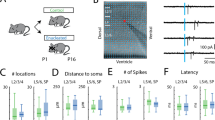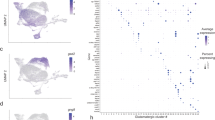Abstract
The cat retinogeniculocortical pathways are organized chiefly into two parallel independent neuronal streams, one involving X-cells of the retina and lateral geniculate nucleus, and the other, Y-cells1,2. Development of the Y-cell pathway is more seriously affected by visual deprivation than is the X-cell pathway2,3 and we reasoned that some insight into the underlying mechanisms of these effects could be gained from studies of normal development. We therefore injected horseradish peroxidase into physiologically identified X- and Y-cell retinogeniculate axons to examine the postnatal development of their terminations in kittens. As we report here, at 3–4 weeks of age, most optic tract axons can be identified physiologically as members of the X- or Y-cell class. X-cell terminal fields in lamina A or Al are wider at 3–4 weeks than they are in adults, while Y-cell terminal fields are narrower than in adults4,5. During the second and third postnatal months, X-cell terminal arbors progressively contract while Y-cell arbors expand so that, by 12 weeks of age, the adult pattern is seen. These data, and the results of our earlier study of the effects of monocular lid suture on these terminal arbors3, suggest that enlargement of Y-cell terminations in geniculate lamina A or Al during development may be accompanied by competitive pruning of X-cell terminations within these same laminae.
This is a preview of subscription content, access via your institution
Access options
Subscribe to this journal
Receive 51 print issues and online access
$199.00 per year
only $3.90 per issue
Buy this article
- Purchase on Springer Link
- Instant access to full article PDF
Prices may be subject to local taxes which are calculated during checkout
Similar content being viewed by others
References
Stone, J., Dreher, B. & Leventhal, A. Brain Res. Rev. 1, 345–394 (1979).
Sherman, S. M. & Spear, P. D. Physiol. Rev. 62, 738–855 (1982).
Sur, M., Humphrey, A. L. & Sherman, S. M. Nature 300, 183–185 (1982).
Sur, M. & Sherman, S. M. Science 218, 389–391 (1982).
Bowling, C. B. & Michael, D. R. Nature 286, 899–902 (1980).
Daniels, J. D., Pettigrew, J. D. & Norman, J. L. J Neurophysiol. 41, 1373–1393 (1978).
Wilson, J. R., Tessin, D. E. & Sherman, S. M. J Neurosci. 2, 562–571 (1982).
Friedlander, M. J., Lin, C.-S., Stanford, L. R. & Sherman, S. M. J. Neurophysiol. 46, 80–129 (1981).
Hoffmann, K.-P., Stone, J. & Sherman, S. M. J Neurophysiol. 35, 518–531 (1972).
Hochstein, S. & Shapley, R. M. J. Physiol., Lond. 262, 237–264 (1976).
Adams, J. C. Neuroscience 2, 141–145 (1977).
Mangel, S. C., Wilson, J. R. & Sherman, S. M. J. Neurophysiol. 50, 240–262 (1983).
Hamasaki, D. I. & Sutija, V. G. Expl Brain Res. 35, 9–23 (1979).
Cleland, B. G. & Levick, W. R. J. Physiol., Lond. 240, 421–456 (1974).
Rusoff, A. C. & Dubin, M. W. J. Neurophysiol. 40, 1188–1198 (1977).
Friedlander, M. J., Vahle-Hinz, C. & Martin, K. A. C. Invest. ophthal. vis. Sci. (ARVO Abstr.) 24, Suppl. 138 (1983).
Mason, C. A. Neuroscience 7, 541–559 (1982).
Hubel, D. H. & Wiesel, T. N. J. Physiol., Lond. 206, 419–436 (1970).
Walsh, C., Policy, E. H. & Hickey, T. L. Nature 302, 611–614 (1983).
Torrealba, F. Guillery, R. W., Eysel, U., Polley, E. H. & Mason, C. A. J. comp. Neurol. 211, 377–396 (1982).
Purves, D. & Lichtman, J. R. Science 210, 153–157 (1980).
Shatz, C. J. J. Neurosci. 3, 482–499 (1983).
Sretavan, D. W. & Shatz, C. J. Nature 308, 845–848 (1984).
Author information
Authors and Affiliations
Rights and permissions
About this article
Cite this article
Sur, M., Weller, R. & Sherman, S. Development of X- and Y-cell retinogeniculate terminations in kittens. Nature 310, 246–249 (1984). https://doi.org/10.1038/310246a0
Received:
Accepted:
Issue Date:
DOI: https://doi.org/10.1038/310246a0
This article is cited by
-
The Dorsal Nucleus of the Lateral Geniculate Body: Anatomy, Histology, Ontogenesis
Neuroscience and Behavioral Physiology (2023)
-
Characterization of signaling function and expression of HLA class I molecules in medulloblastoma
Journal of Neuro-Oncology (2011)
-
Topography of Auditory Nerve Projections to the Cochlear Nucleus in Cats after Neonatal Deafness and Electrical Stimulation by a Cochlear Implant
Journal of the Association for Research in Otolaryngology (2008)
-
Diverse receptive fields in the lateral geniculate nucleus during thalamocortical development
Nature Neuroscience (2000)
-
Retinal ganglion cell dendritic development and its control
Molecular Neurobiology (1996)
Comments
By submitting a comment you agree to abide by our Terms and Community Guidelines. If you find something abusive or that does not comply with our terms or guidelines please flag it as inappropriate.



